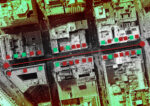San Francisco’s Vacant to Vibrant is expanding from Downtown to Union Square in the coming months, according to SF New Deal, the small-business-supporting nonprofit that runs the free-rent retail and restaurant pop-up program with the city.
With funding from the mayor’s office and the Office of Workforce and Economic Development, the new Vacant to Vibrant budget allocates nearly $3 million to extend and expand the program — which provides grants and connects small business entrepreneurs to property owners with vacant spaces — in phases over the next two years. About $1 million will support the general expansion of the pop-up program, while $2 million will go specifically towards pop-ups in Union Square.
“People want to see Powell Street not only come back, but see it come back better than ever,” said Sarah Dennis Phillips, executive director of OWED, adding that the investment will “inject new energy” into the street and create confidence among other businesses that “want to take the plunge.”
Union Square had a 23 percent retail vacancy rate in the third quarter, according to Avison Young data, compared with 6.4 percent for the city at large, if the neighborhood is not included.
That’s 750,000 square feet of available space in Union Square alone, much of which is centered along Powell Street, where tourists come for the city’s famous cable cars and are now met with enormous empty storefronts that used to house H&M, the Gap, Uniqlo and more. Macy’s has only committed to keeping its flagship Union Square store just off Powell open into 2025.
The expansion program will activate approximately 25 new Vacant to Vibrant storefronts both on Powell Street and across Downtown, according to a press release from Mayor London Breed. The small businesses chosen to participate will receive grants and technical assistance, and property owners will receive stipends to help with utility costs and tenant improvements.
Unlike the cohort plan of the past, where a batch of 10 or so pop-ups would open all at once, these new spaces are expected to open on a rolling basis starting in 2025. Construction on a redesigned Powell Street is also scheduled to begin next year so the timing of the expanded pop-up program is fortuitous, said Marisa Rodriguez, CEO of the Union Square Alliance.
“Every world-class city needs a thriving gateway, and Powell Street is that entry point for San Francisco,” she said.
Since its launch in 2023, Vacant to Vibrant has focused on the Financial District, SoMa and East Cut neighborhoods. Among the nine storefronts that opened last year, seven signed long-term leases and another eight storefronts were activated this year for three-month free leases that were all extended to six months. It is too soon to know how many in the second batch will become permanent.
More than 1,200 small businesses have applied to take part in the program, and interest from the owner community has increased as well, said Simon Bertrang, executive director of SF New Deal.
“The value of the program is evident to them, based on the conversations that we’re having,” said Bertrang, who added that he has been getting unsolicited calls from landlords who want to offer up their spaces for free to local small businesses if the program expands to their areas.
The days of thinking about ground-floor retail as a profit center are gone for now, said Cameron Baird, Avison Young’s senior vice president of retail leasing. Instead, these spaces have become an amenity to draw office tenants to San Francisco’s one-third-vacant Downtown buildings.
“Owners understand where their rents are coming from,” he said, adding that small businesses provide the added bonus of being more flexible than some national tenants. “Some of these local tenants can curate what they do to the environment that they’re in and they can be creative with spaces that may be more second-generation or nontraditional than what a Starbucks needs.”
Bertrang said the small businesses in small spaces model that has worked thus far will have to be modified for Powell Street, where the footprints are much larger. It will likely involve finding small businesses at a later stage in their development and others that could be grouped together to “curate a marketplace.” The pop-ups would also likely last longer — a year rather than three or six months — due to the increased tenant improvement dollars required.
“It’s going to be a different model of Vacant to Vibrant, but it’s going to have the same kind of vision,” he said. “Can we bring in small businesses to create a relationship with property owners to see if there’s something there that can help define a new layer of retail for Union Square?”
Read more



